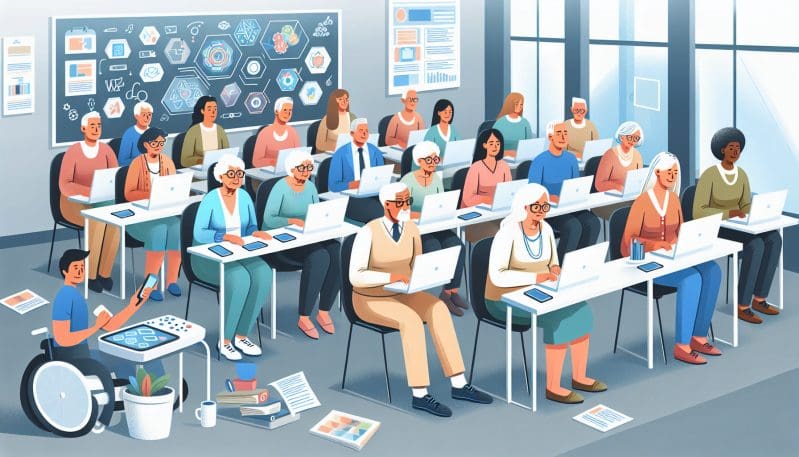Bridging the Digital Divide: Reskilling the Aging Workforce for an Inclusive Future
- Home
- Bridging the Digital Divide: Reskilling the Aging Workforce for an Inclusive Future

- Editors Desk
- January 12, 2024
- 0 Comments
In the rapidly evolving landscape of the 21st century, technology stands as the great disruptor, altering the face of entire industries and the nature of work itself. While the digital transformation promises enhanced efficiency and new opportunities, it also poses a significant challenge for a critical segment of the workforce: older employees. These seasoned professionals often find themselves on the periphery of the technological revolution, grappling with the fear of obsolescence amidst a digital surge. At No Worker Left Behind, we believe that taking proactive measures to reskill the aging workforce is not just a societal imperative but also a strategic business practice that can lead to greater workplace inclusion and productivity.
The Importance of Reskilling Programs
Age should never be a barrier to opportunity, and yet, for many senior workers, the pace of technological change has set forth a daunting learning curve. Reskilling programs specifically tailored to the needs of these individuals are critical for several reasons. Firstly, they provide older workers with the tools to remain competitive and valuable in the job market, ensuring that their wealth of experience and knowledge continues to benefit industries. Secondly, such initiatives foster an inclusive work environment by signaling that every employee, regardless of age, has a place in the future of work. Finally, they mitigate the risks of a shrinking workforce due to retirements, helping to address skill shortages across various sectors.
Successful Case Studies
Evidence of the efficacy of reskilling initiatives aimed at older employees is compelling. For instance, AT&T’s multi-year ‘Workforce 2020’ reskilling program stands as a testament to the potential of such efforts. By offering a wide array of learning resources—from online courses to degree programs—AT&T has enabled its workforce to adapt to the shifting technological landscape. As a result, thousands of employees have successfully transitioned into new roles, invigorated by the opportunity to learn and grow within the company. Another example is found in Germany, where the ‘Work 4.0’ initiative led by the Federal Ministry of Labour and Social Affairs focuses on shaping a future-oriented labor policy that embraces technological advancements while ensuring workers are not left behind.
The Role of Public and Private Sectors
The journey towards a digitally inclusive workforce is a shared responsibility. The private sector, recognizing the strategic advantage of a skilled and diverse employee base, must invest in comprehensive reskilling and upskilling programs. Simultaneously, the public sector must create supportive policies and funding mechanisms that facilitate lifelong learning and skill development. Collaboration between government, industry, educational institutions, and non-profits is essential to creating an ecosystem that values and supports the learning journey of older workers.
Actionable Strategies for Businesses
To ensure that the digital transformation is an inclusive one, No Worker Left Behind proposes several actionable strategies for businesses:
1. Conduct skills gap analyses to identify specific areas where reskilling is required for older workers.
2. Design learning programs that are accessible and tailored to accommodate different learning preferences and paces.
3. Foster mentorship and reverse mentoring programs where older employees can share their industry experience while gaining tech-savvy insights from younger colleagues.
4. Encourage a culture of continuous learning, reassuring older workers that it’s never too late to acquire new skills.
5. Partner with educational institutions and online learning platforms to provide structured learning pathways that lead to certifications or qualifications.
6. Advocate for policies that support workforce re-education, and engage in public-private partnerships that amplify the impact of reskilling efforts.
In conclusion, at No Worker Left Behind, we envision a future where the digital divide is bridged not just through technology, but through deliberate, human-centric efforts to include aging workers in the digital narrative. By reskilling and upskilling the aging workforce, we not only preserve their valuable contributions to the economy, but we also reinforce the foundation for a transformative, inclusive, and prosperous future of work. As we move forward, let us remember that the workforce’s diversity, including age, drives innovation, resilience, and success.

Leave A Comment